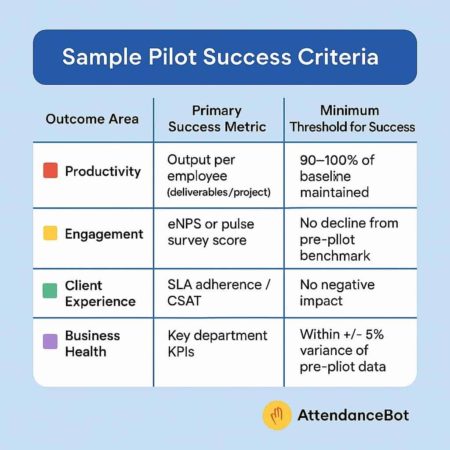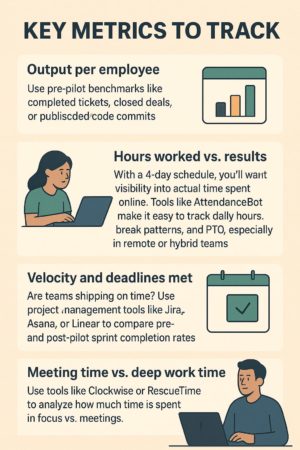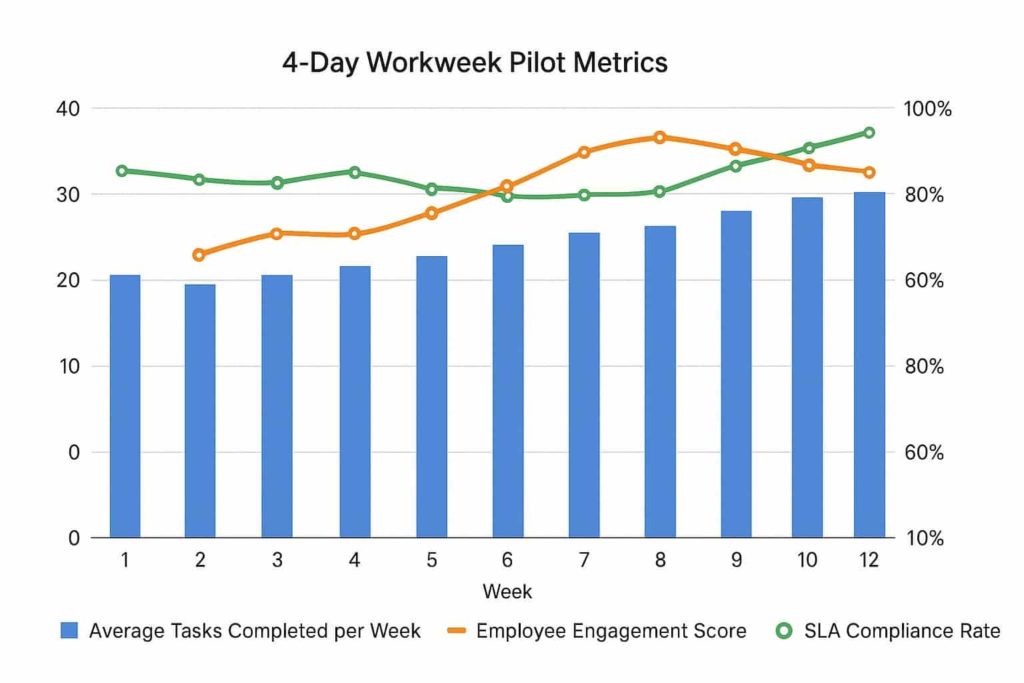The idea of a four-day workweek has evolved from radical to realistic and is rapidly gaining momentum. Whether it’s employee feedback, a CEO’s curiosity, or the pressure to compete for top talent, more tech companies are testing the waters. Running a 4-day week pilot HR leaders can stand behind isn’t just about shifting schedules. It’s about proving, through data, that productivity isn’t lost when hours are reduced. But how do you measure success when your workforce is doing less time but aiming for the same outcomes?
This guide breaks down how to approach reduced hours tracking, identifies the key productivity metrics to monitor, and outlines how to report the pilot’s impact in a way that resonates with both executive teams and employees. If you’re preparing to lead a 4-day week trial in 2025, this is the blueprint to do it right.
Set the Foundation: Define Success and Align with Leadership
Before you track a single data point or draft a new schedule, you need alignment. A 4-day week pilot HR leaders can confidently stand behind starts with clarity: What are we trying to achieve, and how will we know it’s working?
Without a shared definition of success, your pilot can quickly turn into a debate, rather than a decision-ready case study. This section helps you get everyone, from your leadership team to department heads, on the same page before launch.
Clarify the “Why” Behind the Pilot
Start by defining what’s motivating this move. Is it:
- A response to employee burnout or engagement dips?
- An edge in competitive recruiting markets?
- A strategic experiment to test future-of-work readiness?
Naming the “why” sets the tone for how performance will be evaluated and helps align expectations at all levels. Make it clear that this is a time-bound experiment, not a permanent policy—yet.
Identify and Align on Core Outcomes
Before building out KPIs, align with leadership on what “success” really looks like across four pillars:
- Productivity: Are teams meeting deliverables and maintaining performance?
- Engagement & Wellbeing: Are employees feeling more energized and less burned out?
- Client Satisfaction: Are SLAs and quality of service unaffected?
- Business Health: Are key indicators (e.g., sales, support tickets, project velocity) steady or improving?
Use a working session with department heads and execs to define a few non-negotiables vs. nice-to-haves in each area.
Sample Pilot Success Criteria
Here’s a quick framework to help guide your internal conversations:

Frame the Pilot as a Data-Driven Experiment
To ease concerns from skeptical stakeholders, emphasize that the pilot is:
- Temporary – usually 8–12 weeks
- Measurable – with pre- and post-pilot baselines
- Reversible – if results don’t justify continued investment
This mindset keeps the conversation grounded in business impact rather than employee preference alone, making it easier to gain executive trust.
Questions to Use in Leadership Alignment Conversations
Use these prompts to facilitate deeper alignment:
- What business risks are we most concerned about during the pilot?
- What performance benchmarks are critical to maintain?
- What would make us feel confident in extending or ending the pilot?
- What does failure look like, and are we okay with it if we learn from it?
Document these answers. They’ll become your internal scorecard later when it’s time to assess and report outcomes.
What to Track During Your 4-Day Workweek Pilot (And How to Measure It)
Once your goals are aligned, it’s time to get tactical. A successful 4-day week pilot, HR teams can evaluate clearly hinges on one thing: tracking the right data. You need metrics that reflect not only business continuity but also employee sentiment, productivity, and client satisfaction.
Here’s how to build a well-rounded tracking framework that speaks to both executive concerns and employee experience.
📊 Productivity Metrics That Matter
The most common concern during a reduced hours tracking initiative is whether output will slip. You’ll need to distinguish between activity and impact, and lean into team-level trends rather than micromanaging individuals.
Key Metrics to Track:
- Output per employee: Use pre-pilot benchmarks like completed tickets, closed deals, or published code commits.
- Hours worked vs. results: With a 4-day schedule, you’ll want visibility into actual time spent online, not just time scheduled. Tools like AttendanceBot (for Slack or Microsoft Teams) make it easy to track daily hours, break patterns, and PTO, especially in remote or hybrid teams.
- Velocity and deadlines met: Are teams shipping on time? Use project management tools like Jira, Asana, or Linear to compare pre- and post-pilot sprint completion rates.
- Meeting time vs. deep work time: Use tools like Clockwise or RescueTime to analyze how much time is spent in focus vs. meetings.

How to Measure:
- Collect baseline data from the 4–6 weeks before the pilot
- Track weekly output metrics per team (not individual)
- Share trendline dashboards with department leads every two weeks
😊 Engagement and Wellbeing Signals
A shorter week won’t have an impact if burnout levels remain the same or worsen due to compressed deadlines. HR should treat engagement as a leading indicator of long-term success.
Key Metrics to Track:
- eNPS (Employee Net Promoter Score): Run before, during, and after the pilot
- Pulse surveys: Ask targeted questions like “I feel more energized after the long weekend” or “I have enough time to complete my work”
- Time-off usage: Are people using fewer sick days or burnout leave?
How to Measure:
- Use tools like Culture Amp, Officevibe, or Lattice to automate recurring pulse surveys
- Compare survey participation and sentiment across pilot and non-pilot teams (if applicable)
- Track changes in burnout-related absences, attrition risk, and calendar overload
🤝 Client and SLA Impact
For customer-facing teams, you’ll need data that reassures leadership that your client experience remains strong.
Key Metrics to Track:
- SLA adherence: On-time delivery of support, implementation, or client services
- First response time/resolution time: Especially for support or CX teams
- CSAT or NPS: Run client surveys during the pilot window
How to Measure:
- Use platforms like Zendesk, Intercom, or Freshdesk to track customer service performance
- Use Salesforce or HubSpot for CRM-based feedback and timeline adherence
- Monitor Trustpilot, Google reviews, or social channels for qualitative insights
📈 Business and Team-Level Health
Finally, you’ll need broader business KPIs to ensure performance is holding steady or improving.
Key Metrics to Track:
- Revenue and pipeline movement
- Bug rates or QA feedback
- Internal deadlines hit vs. missed
- Time to hire / candidate pipeline health (especially if a 4-day week is a recruiting strategy)
How to Measure:
- Use dashboards from Looker, Tableau, or Power BI
- Compare pre- and post-pilot revenue metrics, churn rates, or project delivery timelines
- Monitor applicant volume and candidate quality using Greenhouse, Lever, or Workable
Dashboard Snapshot: Tracking the 4-Day Workweek Pilot
This visual dashboard summarizes the progress of a 12-week 4-day workweek pilot. The blue bars represent average tasks completed per week, while the orange and green lines show employee engagement scores and SLA compliance, respectively.
The visualization highlights how key performance indicators evolved throughout the trial, helping present insights clearly to stakeholders and support data-backed decisions on whether to continue or scale the pilot.

📋 Bonus: Create a Pilot Scorecard Template
To synthesize all this, create a simple “pilot scorecard” that visualizes trends across categories like this:
| Category | Metric | Baseline | Week 4 | Week 8 | Trend |
| Productivity | Completed tasks/team | 120 | 115 | 130 | ⬆️ |
| Engagement | eNPS | 45 | 50 | 52 | ⬆️ |
| Client Experience | SLA on-time % | 98% | 97% | 99% | ➡️ |
| Business Health | Revenue booked | $200K | $190K | $205K | ➡️ |
You can build this in a Google Sheet, Airtable, or your internal BI tool. Share it weekly or biweekly with stakeholders to build trust and transparency during the pilot.
How Are the USA, UK, Canada, and Australia Embracing the 4-Day Workweek?
The 4-day workweek is gaining traction across major English-speaking countries. Here’s how each is approaching the concept:
🇺🇸 United States
While there isn’t a nationwide policy, several U.S. companies are experimenting with shorter workweeks. For instance, Microsoft Japan’s 2019 trial, which resulted in a 40% increase in productivity, has inspired discussions about similar initiatives in the U.S.
🇬🇧 United Kingdom
The UK conducted the world’s largest 4-day workweek trial in 20, involving 61 companies. The results were promising:
- 89% of participating companies continued the policy post-trial.
- 51% made it permanent.
- 82% of employees reported improved well-being.
- 50% observed reduced staff turnover.
- 32% noted enhanced recruitment efforts.
- 46% experienced increased productivity.
These outcomes have led to discussions about broader adoption and potential government support.
🇨🇦 Canada
Canada is exploring the 4-day workweek, particularly in tech hubs like Toronto and Vancouver. While there isn’t a nationwide pilot, discussions are ongoing about its feasibility and potential benefits for work-life balance and productivity.
🇦🇺 Australia
Australia’s Productivity Commission has highlighted the importance of flexible work arrangements, including the 4-day workweek, in enhancing productivity and employee well-being. While not yet widespread, the concept is gaining attention as part of broader discussions on workplace reforms.
Conclusion
Successfully managing a 4-day workweek pilot isn’t about proving it works for everyone—it’s about learning if it works for your team, your clients, and your business model. By tracking the right productivity metrics, capturing honest employee feedback, and maintaining SLA compliance, you’ll build a compelling, data-backed narrative for your leadership.
Whether the pilot becomes permanent or not, the process itself builds stronger alignment between flexibility and performance. Tools like AttendanceBot can help track hours, measure productivity trends, and support asynchronous collaboration.
In the end, the most successful pilots don’t chase headlines—they design thoughtful experiments, embrace transparency, and act on what the data reveals.



